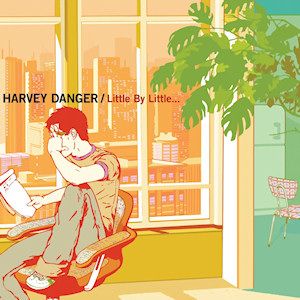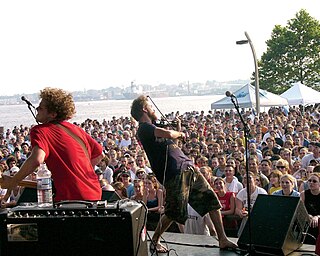
The All-American Rejects are an American rock band from Stillwater, Oklahoma, formed in 1999. The band consists of lead vocalist and bassist Tyson Ritter, lead guitarist and backing vocalist Nick Wheeler, rhythm guitarist and backing vocalist Mike Kennerty, and drummer Chris Gaylor. Wheeler and Ritter serve as the band's songwriters; Wheeler is the primary composer and Ritter is the primary lyricist. Although Kennerty and Gaylor are not founding members, they have appeared in all of the band's music videos and on all studio releases except for the band's self-titled debut.

Michael Andrew "Duff" McKagan is an American musician. He was the bassist of hard rock band Guns N' Roses for twelve years, with whom he achieved worldwide success in the late 1980s and early 1990s. McKagan rejoined the band in 2016, following their induction into the Rock and Roll Hall of Fame.

Harvey Danger was an American indie/alternative rock band. It was formed in 1992 in Seattle, Washington, by Aaron Huffman and Jeff J. Lin, who were both journalism students at the University of Washington. Drummer Evan Sult and singer Sean Nelson were brought into the band in 1993, solidifying the band's lineup for the remainder of their initial existence.
Slash Records was an American record label originally specializing in local punk rock bands, active from 1978 to 2000. It was notable as one of the first and most successful independent record labels in alternative music, before its eventual acquisition by Warner Music Group.

King James Version is the second studio album by American rock band Harvey Danger, released on September 12, 2000, through London-Sire Records. It was the band's only album recorded for a major label, and their last with drummer Evan Sult. Written and recorded over the span of 16 months with producer John Goodmanson, the album marked a substantial departure from the lo-fi sound of the band's debut, Where Have All the Merrymakers Gone? (1997); it encompassed a variety of rock music styles and explored "the conflict between faith and skepticism". Although the bulk of the album's material was recorded in March and April 1999, work on the album continued periodically until February 2000 due to a dispute surrounding Harvey Danger's contract, which delayed its release.

Autolux is an American alternative rock band formed in Los Angeles, California in 2001. The group formed as a trio and have released three full-length albums, Future Perfect (2004), Transit Transit (2010) and Pussy's Dead (2016). Their sound draws from post-punk, electronic music, krautrock and shoegaze.

Sometimes You Have to Work on Christmas (Sometimes) is the second EP by Harvey Danger. It was released in December 2004 on the band's own label, Phonographic Records. One of the songs is a demo from their next album, Little by Little..., two are different recordings of past songs, and the remaining two are rare songs, released only on special collections in the past.

Sean Nelson is an American musician and journalist. He was the lead singer of the alternative rock group Harvey Danger.

Little by Little... is the third and final studio album by Harvey Danger. It is the band's first and only album with drummer Michael Welke, replacing the band's original drummer Evan Sult.

March ör Die is the tenth studio album by British rock band Motörhead, released in August 1992. It would be the band's second and final album with WTG Records. The album features guest appearances by Ozzy Osbourne, Guns N' Roses guitarist Slash, and veteran drummer Tommy Aldridge. Aldridge stepped in after longtime member Phil Taylor was fired early in the recording process.

Dig Me Out is the third studio album by the American rock band Sleater-Kinney, released on April 8, 1997, by Kill Rock Stars. The album was produced by John Goodmanson and recorded from December 1996 to January 1997 at John and Stu's Place in Seattle, Washington. Dig Me Out marked the debut of Janet Weiss, who would become the band's longest-serving drummer. The music on the record was influenced by traditional rock and roll bands, while the lyrics deal with issues of heartbreak and survival. The album cover is an homage to the Kinks' 1965 album The Kink Kontroversy.

"Flagpole Sitta" is a song by American rock band Harvey Danger from their 1997 debut album, Where Have All the Merrymakers Gone? It was released as the band's debut single in April 1998 and was met with critical and commercial success, peaking at number 38 on the US Billboard Hot 100 Airplay chart, number three on the Billboard Modern Rock Tracks chart, and number nine on the Canadian RPM Alternative 30. A music video was produced to promote the single.
John Goodmanson is an American recording engineer and indie rock record producer. He is best known for producing multiple albums by Bikini Kill, Blonde Redhead, Death Cab for Cutie, Los Campesinos!, and Sleater-Kinney.

The Hall of Justice is a recording studio in the Ballard neighborhood of Seattle, Washington. The triangular-shaped building, which has changed ownership and purpose throughout its century-old history, has functioned as a studio for rock bands since the 1970s. The windowless, unassuming space has been home to the recordings of albums by seminal indie rock bands, including Nirvana, Soundgarden, Death Cab for Cutie, Fleet Foxes, the Decemberists, Sleater-Kinney, Built to Spill, Modest Mouse, and more.

In an Expression of the Inexpressible is the fourth studio album by American alternative rock band Blonde Redhead. It was released on September 8, 1998, by Touch and Go Records.

Mike Squires is an American musician best known as the lead guitarist in the hard rock group Loaded, the group led by Velvet Revolver and Guns N' Roses bassist Duff McKagan.

ZOX is a rock band from Providence, Rhode Island. The band consists of four members: namesake John Zox (drums), Eli Miller, Spencer Swain, and Dan Edinberg.
"Rose Red Violent Blue " is a song by American rock band Stone Sour. It was a single off of their album Hydrograd. As of February 2018, it had peaked at number 10 on the Billboard US Mainstream Rock Songs chart.















